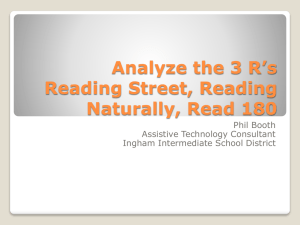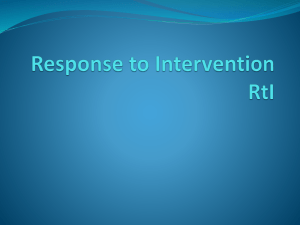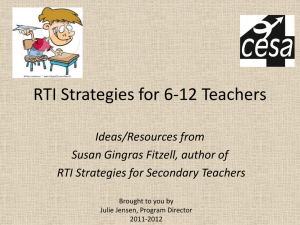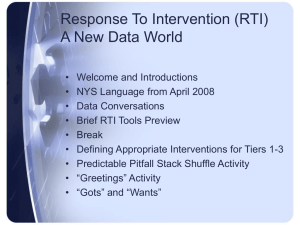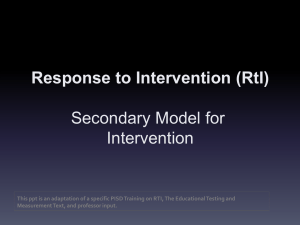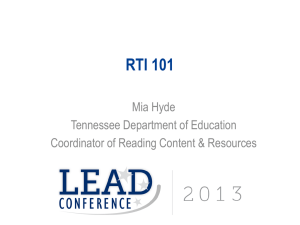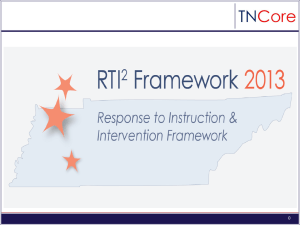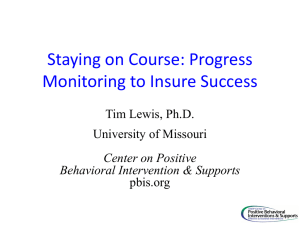Lazega - Florida Charter School Conference
advertisement
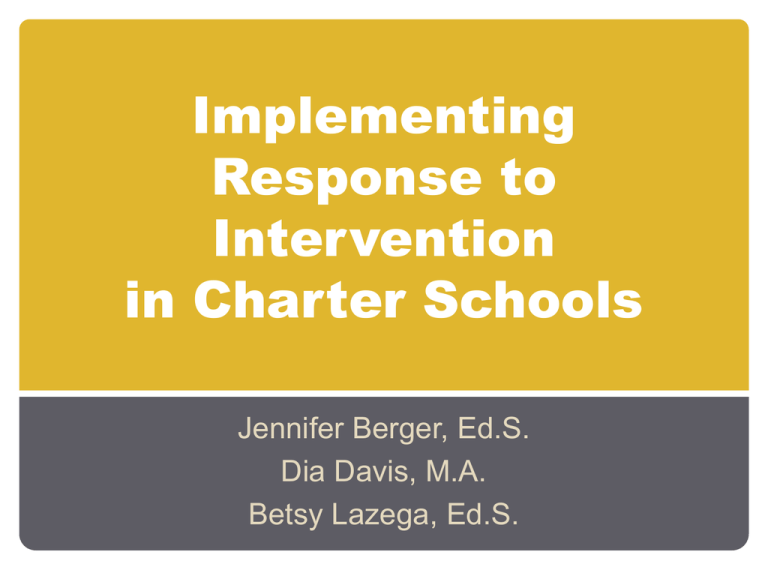
Implementing Response to Intervention in Charter Schools Jennifer Berger, Ed.S. Dia Davis, M.A. Betsy Lazega, Ed.S. Outline Overview of PS/RtI Teams and Roles Resource Mapping Using Data to Drive Instruction/Intervention Data- What, Why, When Scheduling Intervention Fidelity Parent Involvement Strengths and Weaknesses RtI in Charter Schools Includes: Academics, Behavior, and Enrichment Tier III (Core + Supplemental + Intensive Individual Instruction) For Approx 5% of Students…to obtain (if below) or exceed (if above) benchmarks Tier III is considered effective if students increase needed skills or accelerate beyond expectations. Tier II: ( Core + Supplemental) For approximately 20% of students…to achieve (if below) or exceed (if at or above) benchmarks Tier II is considered effective if at least 70-80% of students improve performance (i.e., gap is closing towards benchmark or students are exceeding benchmarks). TIER I: Goal: 100% of students achieving or exceeding benchmarks Tier I is considered effective if at least 80% or more of the students are meeting or exceeding benchmarks with access to Core/Universal Instruction. 4 Adapted from Brian Gaunt Florida Law 6A-6.0331 General Education Intervention Rule Schools must provide coordinated general education intervention procedures for any student who needs additional academic or behavioral support to succeed in general education classroom. Tenants Monitor the effectiveness Identify Select & implement researchbased interventions Analyze Traditional vs. Response to Intervention Intervention J L Intervention Traditional Intervention Response to Intervention J L Monitor Progress Intervention J L J L Consider ESE Monitor Progress Intervention J General Education Consider ESE If necessary A Shift in Thinking The central question is not: “What about the students is causing the performance discrepancy?” but “What about the interaction of the curriculum, instruction, learners and learning environment should be altered so that the students will learn?” This shift alters everything else Ken Howell How do you KNOW if instruction was working for all students? Student Grade Level Jared Standard 9 RtI… IS NOT: IS: • A way to avoid special education placement • A process designed to maximize student achievement • A hoop to jump through to ensure special education placement • Focused on outcomes • About student progress Teams & Roles Problem Solving Leadership Team (PSLT) Professional Learning Community(PLC)/Teacher Team Specialty PSLT/Tier 3 Team Teams & Purpose PSLT (Core): • School-wide universal screeners, attendance data, behavioral data Teacher Teams (Supplemental): • Grade level assessments, grade level attendance, grade level behavior Specialty PSLT (Intensive): • Student assessment, behavior/attendance data and comparison data Video- Teams Resource Mapping Resource Mapping What is it? • The process of aligning resources to achieve goals for student success at each level of support Why do it? • Collaboratively establish an inventory of resources available to our school to help students succeed Where do we find resources? Teachers School District Community What do you mean by “resource”? People Materials Time Assessments Technology Resource Mapping Resource Maps are created for academic areas as well as for behavior. Resources available at each tier level are included. Resource Maps Using Data to Drive Instruction/ Intervention Data Walls & Rooms Purpose Construction • Visually track student data to improve student academic achievement and group students based upon instructional need. • Data walls are sorted by grade level and/or subject area: • Each teacher on the team has a different color post-it note. • Student data are recorded on the postit note and a representative from the PLC moves each student’s post-it note to reflect their progress. .. School-wide Data Room 23 Science School-wide Goal from School Improvement Plan School Target Proficiency line The graph is created based on the measures of the test. In this example, we marked the proficiency line as given by the district as well as our own “target” line. 25 26 Classroom-based DRA Data Wall Secondary Electronic Data Wall INTERPRETING THE DATA WALL Chron Age Under Age for Grade FCAT DSS Rdg 2008 - 2009 FCAT Level FCAT DSS FCAT Level Performance Rdg Math Math on FAIR 2008 - 2009 2008 - 2009 2008 - 2009 Rdg DSS Ranges for Level 4 or 5 Levels 4 and 5 UnEx. Abs Suspensions District GPA Under Age for Grade Math DSS Ranges for Levels 4 and 5 Appropriate Age for Grade Math DSS Range for Level 3 0 to 5 0 to 5 3.0 to 3.99 4.0 or > No Appropriate Rdg DSS Range Age for Level 3 for Grade Level 3 PRS or FSP ≥ 85 Yes 1 Year Over Age Rdg DSS Range for Grade for Level 2 Level 2 PRS or FSP 1 Year Over Between 16 Age and 84 for Grade Math DSS Range for Level 2 6 to 10 6 to 10 2.0 to 2.99 Level 1 2 Yrs or More Over Age for Grade Math DSS Range for Level 1 11 to 15 11 to 15 1.0 to 1.99 2 Yrs or More Rdg DSS Range Over Age for Level 1 for Grade PRS or FSP ≤ 15 Total Credits Earned 16 or more 16 or more 0 to .9 Determined by the time of the school year. Overage for Grade Video of Virtual Data Wall Using and Interactive Smart Board Click..\Virtual Data Wall.wmv to Play Setting Goals Identify the intervention goal or target that you want the student to attain. Goals in tiers 2 & 3 should be short term (e.g., next benchmark assessment period). Goals Goals have 2 components: • 1. Level of performance desired. • 2. Time within which that level can be attained. Goals should be ambitious but reasonable. SMART Goals Strategic Measurable Attainable Results based Time-bound AND with …. Built in Accountability • Conzemius & O’Neill Data What? Why? When? Types of Assessment Screening and Benchmark • Which of our students might possibly need additional assistance in order to be successful academically? Diagnostic • What are the student’s academic strengths and instructional needs? Progress Monitoring • Is learning happening? Outcome Assessment • Did our students make progress towards meeting the standards? Progress Monitoring Tools Core • Running Records • DRA-2 • FCAT Weekly Practice Tests • Chapter tests Intervention • Fluency-based assessments • FCRR OPM • Monthly assessments from research-based computerized programs (e.g., istation) • Read 180 assessments • EasyCBM Video- Using Data Scheduling Building in Time for Intervention/Enrichment Master Schedule Based on the least restrictive impact on core subjects Establish a year-long timeline including: coordinator/interventionist meetings bi-weekly team meetings data analysis checkpoints Video-Scheduling Sample Schedule Fidelity Monitoring the integrity of implementation Research Shows… Lack of implementation fidelity might result in a practice or program being less effective, less efficient, or producing less predictable responses. (Wilder, Atwell, & Wine, 2006; Noell, Gresham, & Gansle, 2002) When programs implemented with fidelity are compared to programs not implemented with fidelity, the difference in effectiveness is profound. Those implemented with fidelity yield average effect sizes that are two to three times higher. (Durlak & DuPre, 2008) Questions Addressing Fidelity Who: • is responsible for delivering the instruction/intervention? • is available to provide guidance or assistance? What: • are the roles of teachers, support personnel, school coaches, and administrators? • will we do when the interventionist/teacher is absent? How: • will we proceed if a lesson is missed or interrupted due to schedule alterations (e.g., a fire drill, field trip, assembly)? Instructional Fidelity Interventionists should: Be adequately trained. Adhere to the instructional procedures (e.g., implement among groups of the appropriate size). Implement as frequently as recommended by the publisher (e.g., daily, three times per week). Implement for the recommended amount of time (e.g., one semester, one academic year). Skillfully implement the instructional procedures. Who Conducts Fidelity Checks? A trained: Coordinator Teacher Administrator That can: •collect & analyze data •observe and conduct interviews with interventionists & students receiving instruction/intervention •attest to the quality of the intervention Resource Person Formats of Fidelity Checks AREAS TO CONSIDER FOR ASSESSMENT FORMATS • • • • • • Direct Observations Rating Scales Permanent Products Interview Self-report “Scripted” Interventions • • • • Adherence Exposure Quality of Delivery Program Differentiation • Student Responsiveness Parent Involvement Parent Involvement Meaningful and effective involvement is critical Parents must understand that RtI: is relevant and beneficial to all students, regardless of placement. seeks to find out what specific instruction and interventions work best for their child. is not a categorical system that students must progress through laterally to become eligible for special education. does not override other rights under IDEA. How to Involve Parents at Core Review school-wide data and goals with the Student Advisory Committee (SAC) and Parent Teacher Association (PTA) members. Include information about school-wide data in parent newsletters. Post school-wide data in a visible place on campus. How to Involve Parents in Intervention Tier 2: Invite parent to attend parent conference and/or PSLT meeting; solicit input in a formal manner if unable to attend. Tiers 2 & 3: Invite parents to participate in meetings and/or receive any of the data that is used by the team with a summary of the meeting in writing accompanied by a follow-up telephone call and/or parent/teacher conference. Strengths and Weaknesses RtI in Charter Schools Activity Strengths Weaknesses Strengths Willingness to think outside of the box Different models and approaches to learning Less students, smaller staff creates a greater sense of community More individualized approach More parent involvement Flexibility in scheduling Weaknesses Limited resources- personnel, materials Specificity when progress monitoring (what to use, what to measure) Intervention materials/resources may be less accessible Maintaining communication with district resources Video-The Importance of RtI RtI Resources Florida Center for Reading and Research http://www.fcrr.org Florida Inclusion Network http://www.floridainclusionnetwork.com Florida Response to Intervention (sponsored by FLDOE, BEESS, & others) http://www.florida-rti.org/ National Center for Response to Intervention (US DOE & American Institute for Research) http://www.rti4success.org/ The IRIS Center (Vanderbilt Univ, Claremont Grad School, TA&D, IDEAS that Work) http://iris.peabody.vanderbilt.edu/ RTI Action Network (National Center for Students with Learning Disabilities) http://www.rtinetwork.org/ Curriculum Based Measurement www.easycbm.com RtI Resources What Works Clearinghouse www.whatworksclearinghouse.org Positive Behavior Support http://flpbs.fmhi.usf.edu Guiding Tools for Instructional Support www.florida-rti.org/_docs/GTIPS.pdf
